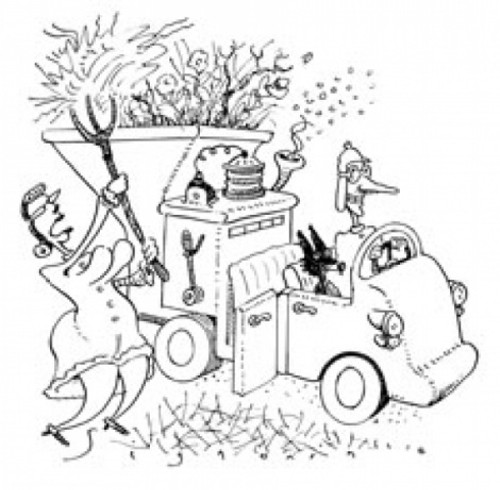Since you’re on an energy kick these days, I thought I would ask you: how viable is cellulosic ethanol? —Rob Dennett, via e-mail
Hang on, Rob—let’s back up a bit, just to make sure everyone’s on board.
Until very recently, when Americans talked about ethanol as fuel, they were talking mainly about ethanol made from corn. Thanks (in part) to bountiful government subsidies and lousy public transit, two of our big national weaknesses are growing more corn than we need and using more gasoline than we should. So there’s a certain kind of short-sighted, conservation-averse sense in trying to address both at once: We’ll just make gas out of corn! (If you could run cars on old episodes of Law & Order, we’d have licked foreign oil dependency years ago.)
Asked a few years back about the merits of corn ethanol production, I noted that the very process of turning corn into car juice required lots of fossil fuels—more than equivalent in energy content, some experts argued, to what you get out of it. Thus, because of all those subsidies, America’s big ethanol push boiled down to a massive and inefficient transfer of 1. energy from one form to another and 2. money from taxpayers to agri-behemoth Archer Daniels Midland.
Naturally, other qualified folks saw it differently, and neither side has since conceded any ground. Fact is, there are so many variables in play here and so little consensus on how to approach them that at times it’s hard to say if the assorted pundits are even answering the same question. Some researchers include the value of coproducts (corn oil, animal feed) resulting from ethanol manufacture, others don’t; various assumptions are made about farming efficiency and crop yields; etc, etc. In a 2005 presentation, Michael Wang of Argonne National Laboratory (a leading voice among the ethanol-makes-sense majority) claimed that using corn-based ethanol instead of gasoline leads to moderate greenhouse-gas reduction. But Nobel-winning chemist Paul Crutzen argued earlier this year that any such reduction is more than canceled out by emissions from the fertilizer used to grow the corn.
One thing Wang and Crutzen agree on, though, is that the balance sheet for cellulosic ethanol is substantially better. (Finally, Rob says.) Instead of relying on the starchy (i.e., typically edible) parts of food plants, cellulosic ethanol can be produced from the more abundant and less usable stuff—stalks, stems, straw, et al—or even from hardier and faster-growing crops altogether, such as hybrid trees or switchgrass, thus theoretically reducing competition for the use of food crops. (Some tie recent corn-price spikes in Mexico to increased ethanol demand, though this may be overblown.) This is a relatively new and pretty cutting-edge process, employing genetically engineered enzymes and bacteria, gasifiers (which convert solid biomass into a gas to feed the hungry bacteria), and lots more high-tech stuff; it may require little or no fossil fuel, as the woody matter (lignin) in the plant fiber can be used to generate the needed power.
The major catch, as you might guess, is that it’s expensive: as of 2005, it cost about $2.25 to make a gallon of cellulose ethanol, and that’s before you’ve gotten it anywhere near a pump. (Corn ethanol can cost half that if corn prices are down.) Currently no producers are operating at real commercial-scale output levels, and assumptions about future efficiency may well be overoptimistic. True, research is advancing quickly, and this year the Energy Department started handing out $385 million for six test-bed cellulosic ethanol refineries. But federal energy policy calls for lots of ethanol and fairly soon—a June Senate bill wants 36 billion gallons in use by 2022, seven times what we’re producing now—so, in the short run, most demand will be met by corn.
OK, but will it be viable later? Depends what you mean. If you’re looking for a cure-all fuel that we can just substitute for gas and thereby keep on doing what we’ve been doing, no, cellulosic ethanol isn’t it—and, barring the arrival by spaceship of some advanced and benevolent race, nothing is. A major report on future motor fuels published by the E.U. in March saw significant benefits, depending on the process used, in ethanol made from wheat or sugar beets (they don’t grow much corn in Europe) and great potential for ethanol made from cellulose. But one of its key conclusions was that, for now at least, there’s no single route to greater energy sustainability—“A wider variety of fuels,” it predicts, “may be expected in the market,” possibly to be used in different blends for assorted niche applications. So, besides improving fuel economy, we’ll need to diversify, and up-and-coming fuels like cellulosic ethanol will almost certainly have a role to play. Not such a sexy vision of the automotive future, perhaps, but it beats hoping for the miracle fuel that’ll preserve our current way of life.
Comments, questions? Take it up with Cecil on the Straight Dope Message Board, StraightDope.com, or write him at the Chicago Reader, 11 E. Illinois, Chicago 60611.
More by Cecil Adams
-
This Is the End, My Friend
This week's Straight Dope marks the last appearance of the column as the Teeming Millions have known it for the past 45 years.
- Jul 11, 2018
-
Do Brain Supplements Do Anything?
Brain Drain
- Jul 4, 2018
-
Is flying really worse for the environment than driving?
Planes and Trains
- Jun 27, 2018
- More »




